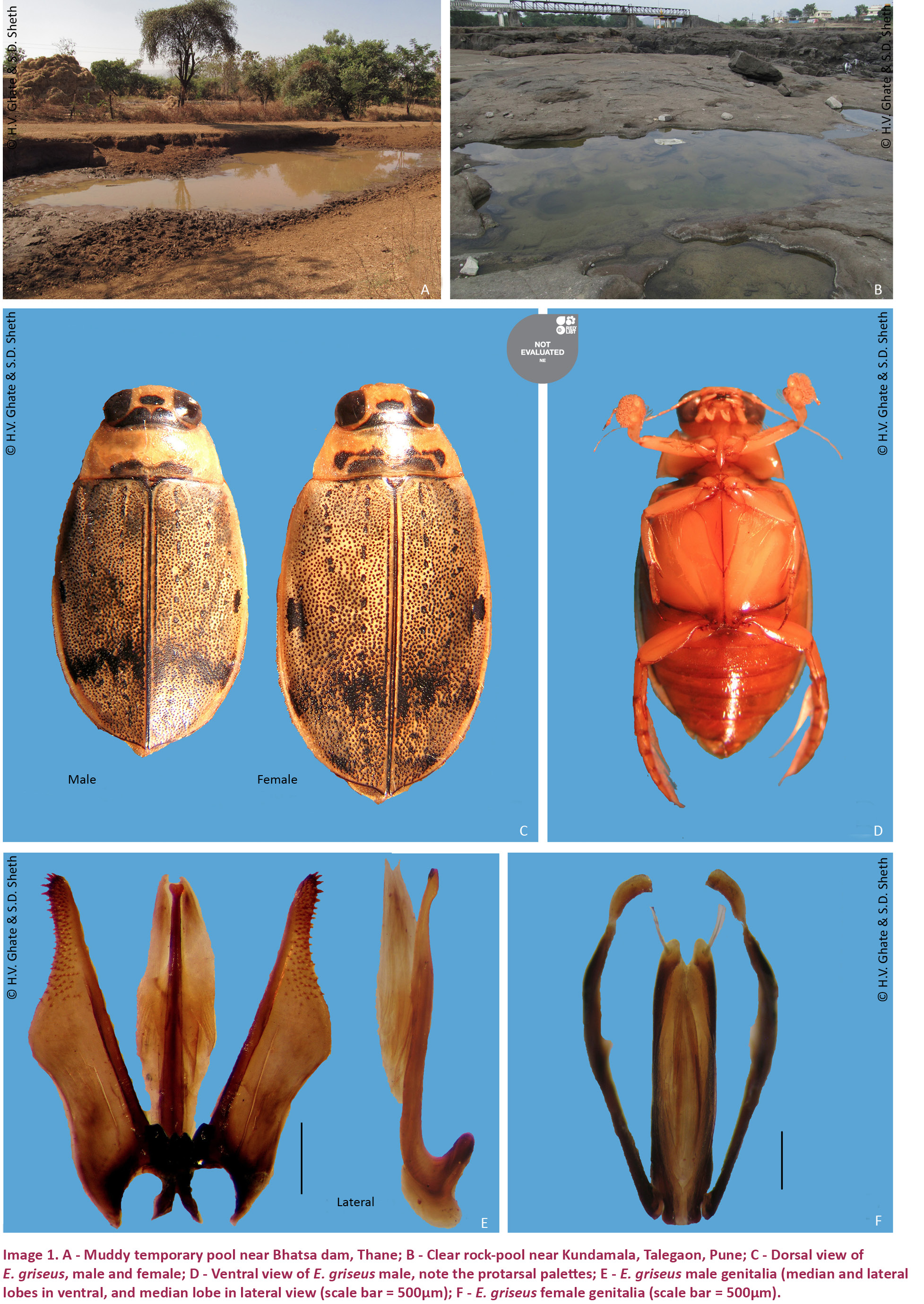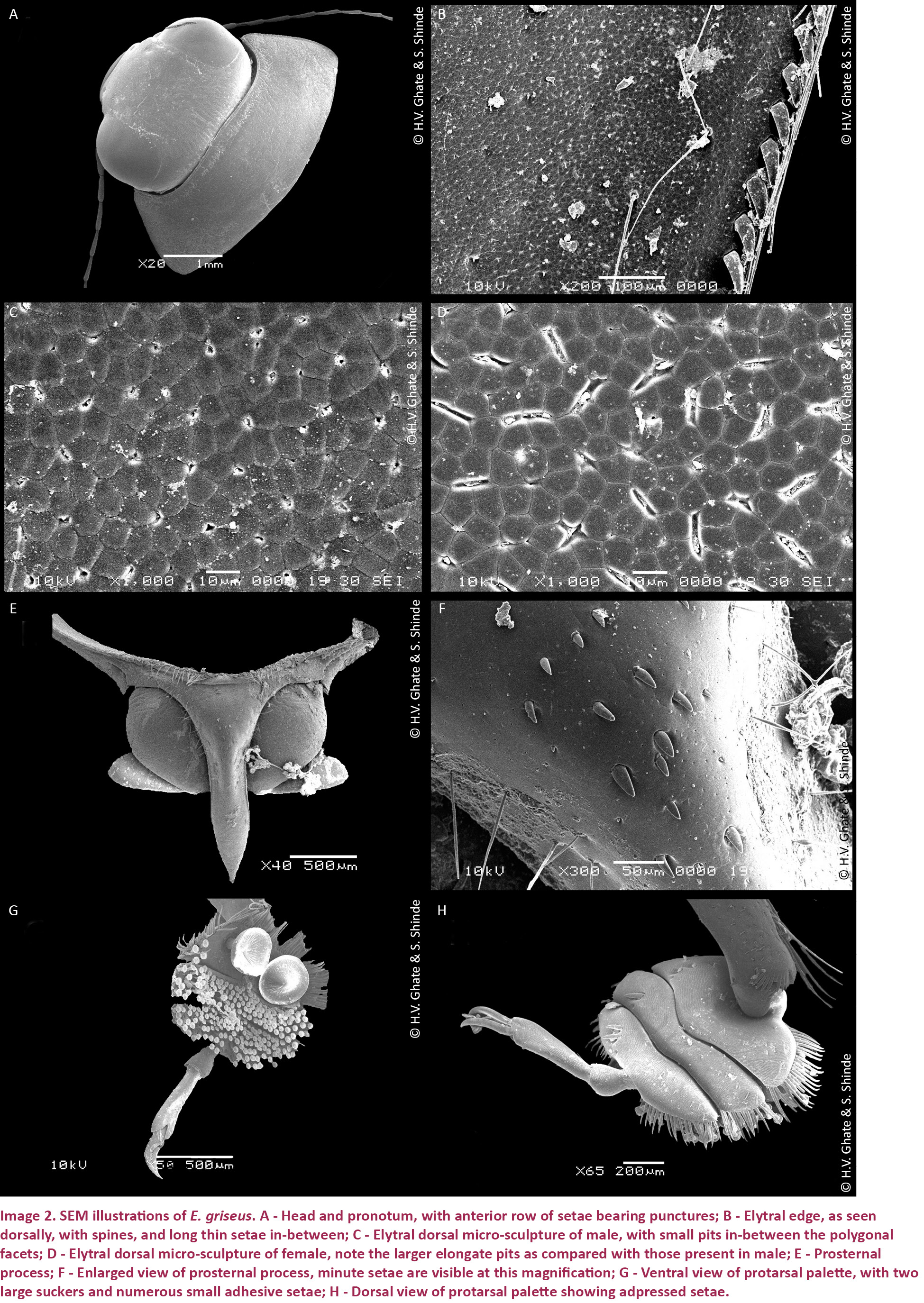Dytiscidae are a large family of aquatic beetles. India and adjacent countries harbour over 330 species, according to the recent catalogue of Dytiscidae beetles, and the genus Eretes Laporte is represented by two species in India—Eretes griseus (Fabricius, 1781) and Eretes sticticus (Linnaeus, 1767)—of these two species, E. sticticus is reported to be present all over India (including Maharashtra), with E. griseus distributed primarily in northern India (Himachal Pradesh, Jammu & Kashmir, Uttar Pradesh). This distribution status (Ghosh & Nilsson 2012) needs revision as shown in this note.
During our inventory of Dytiscidae in and around Pune, we have collected more than 40 species till date. However, specimens of Eretes were found from only three localities (out of some 50+ sites visited) from Maharashtra State. The specimens were easily placed in the subfamily Dytiscinae (‘eyes not emarginate above bases of antennae, first three segments of fore tarsi of male strongly modified, possessing adhesive discs’) and tribe Eretini (‘prosternal process pointed apically, pronotum with sides bordered, elytra partly serrate in posterior part’) based on the keys by Pederzani (1995). The species of Eretes was determined using the keys and characteristics provided in the excellent, recent revision of the genus Eretes (Miller 2002). This revision gives diagrams of elytral coloration, genitalia, and descriptions of all four species of Eretes known in the world today.
Based on a careful examination of the specimens (9 males and 6 females), dissection of male / female genitalia, and comparison of our observations with those given by Miller (2002), it is confirmed that our specimens belong to Eretes griseus (Fabricius). General morphology and colouration is quite variable in this genus but, according to Miller (2002), male genitalia are distinctive and hence morphologically diagnostic. The median lobe in male genitalia of E. griseus has a distinctly broad and expanded apex. Our photographs presented here (Image 1E) clearly show this for the male genitalia. Photographs of the female genitalia also depict the gonocoxae with narrowly rounded apices, and these are almost identical to the illustrations of the female genitalia of E. griseus given by Miller (2002). (Our observations have also been verified personally by Dr. Kelly Miller).
Materials and Methods: Specimens were collected using a hand net with a square frame (mesh size = 1mm, frame dimensions = 25X25 cm) and preserved in absolute ethanol.
Localities: (i) 18.i.2014, temporary roadside pool near Bhatsa dam, Thane, coll. S. Sheth; (ii) 16.ii.2014, temporary roadside pool near Bhama-Askhed dam, near Talegaon-Dabhade, Pune, coll. S. Sheth; (iii) 03.iii.2014, rock-pool at Kundamala, near Talegaon-Dabhade, Pune, coll. S. Sheth. All the three pools had a depth of not more than 100cm. No aquatic vegetation was found in any pool, except some algal mat on the rocky substrate in Kundamala Pool.
Beetles collected were studied and photographed under stereo-zoom trinocular microscope (Leica MZ6) with a photography attachment (Canon PowerShot S50). Several images were taken at different focal planes and were stacked using Combine ZM image-stacking freeware. Measurement of beetles was done using digital caliper (AEROSPACE, 0–150 mm). Beetles were dissected with fine forceps and genitalia were cleaned in 10% KOH before examination and photography. For Scanning Electron Microscopy (SEM), dissected specimens were dehydrated through grades of ethanol, treated with hexamethyldisilazane (HMDS, SRL Chemicals) as per Nation (1983), then mounted on stub, coated with platinum (at a thickness of about 15nm) and examined, scanned and photographed under Analytical SEM (JEOL JSM - 6360A). The digital SEM photographs were processed using Adobe Photoshop CS5 version 12.00. One male and one female from Kundamala pool are preserved at Modern College: Reg. Nos. Coleoptera, Dytiscidae -28 a & 28 b, respectively.
Description: Since the diagnostic characteristics of the genus/species and the synonyms have been already given in Miller (2002), we are giving only brief morphological features of this insect with illustrations. The habitats from where the insects were collected indicated that E. griseus occupies temporary pools, either muddy or clear (Images 1 A&B). Measurements showed that males are slightly smaller and narrower than females [Length - males: 11.73–12.86 mm, females: 12.19–13.4 mm; Width - males: 5.78–6.93 mm, females: 6.62–7.51 mm].
Colour more or less pale reddish-yellow with small black spots spread all over the elytra, either singly or as confluent rounded blotches, patches or bands; head without such small black spots but with dark brown to blackish-band in the basal region and an oblong oval blotch of similar colour in front of the basal band; pronotum also with a basal brown band which is somewhat variable in appearance in both the sexes (Image 1C, male and female dorsal views). Ventrally almost uniform pale cream or brownish-yellow, abdomen with reddish tint in fresh specimens (Image 1D). Sexual dimorphism is distinct: with males having a well-developed protarsal palette; females with slightly broader body and elytra with a lateral, longitudinal depression, just near the middle, where there is a prominent black spot. Male genitalia with the median lobe having distinctly broadly expanded apex, and its shape in the lateral view, is also diagnostic (Image 1E), so also are the female genitalia in which gonocoxae are with narrowly rounded apex (Image 1F).

Head almost rectangular, as seen from above, with angles rounded; eyes large making head broader than anterior margin of pronotum; antennae pale cream and very slender. Pronotum broader than long, anterior lateral angles more or less acute and posterior lateral angles almost right-angled, anterior margin sinuate while posterior margin more or less straight, disc moderately convex, finely punctured with a row of coarser punctures with setae near the anterior edge, as revealed by SEM (see Image 2A).
Elytra moderately convex, almost flat dorsally, thin, translucent, gently rounded at sides, broadest just behind the middle, finely punctured and with partly serrated border near the apical region. This elytral serration is restricted to a small area behind the middle and does not extend up to apex, includes rather blunt and flattish spines which are about 60–65 in number on each side; the place in between the spines is occupied by rather long and thin setae (Image 2B). SEM observations of dorsal surface of elytra in male and female show polygonal sclerites. However, there is some difference in fine structure of elytra of males and females (Images 2 C&D). Elytral apex is produced as a fine ‘beak’.
Ventrally observed, the pointed prosternal process is diagnostic (Image 2E) and it has a series of setae on its surface (Image 2F). Male protarsal palette, with adhesive discs on first three tarsomeres, may also be diagnostic of the species but details of palette of other related species are not available. We provide SEM pictures showing the arrangement of adhesive setae and two large suckers (Image 2G). The first protarsal segment bears two large suckers and three small adhesive setae while the second and third segment bear about 107 adhesive setae each. There is a pattern of adpressed setae on dorsal side of these tarsomeres that form the palette (Image 2H).

Discussion: Vazirani (1967) collected Eretes sticticus in Bombay (Goregaon) and later (1968) mentioned about specimens collected from Panchgani by S. Swell in 1931, also identified as Eretes sticticus. Vazirani (1977) also collected E. sticticus in Moshi, near Poona (now Pune). Vazirani (1968) later provided information on distribution of E. sticticus and mentioned that the species is variable in size, form and colour. Actually, following Guignot (original paper not seen), Vazirani (1968) reported different forms or varieties of E. sticticus: such as, griseus, and succinctus. Miller (2002) has elevated E. sticticus griseus to E. griseus and has also synonymized E. sticticus succinctus to E. griseus. Vazirani (1968) studied material from many places, including Maharashtra, but he did not indicate which variety occurs in which area. The diagram of male genitalia given by Vazirani (1968) is somewhat confusing and does not appear to be that of E. griseus, and the locality of the dissected specimen is also not mentioned in that paper.
Presence of a distinct, short, lateral, longitudinal elytral sulcus in females of three species of Eretes is interesting (see Miller 2002); however, neither Vazirani (1967, 1968, 1977) nor Tonapi & Ozarkar (1969) mentioned this, although it is clearly visible and can be used as one of the sexually dimorphic characteristics for all Eretes, except E. australis (Erichson) (see Miller 2002). According to Vazirani (1968), Eretes males have ‘sucker palettes’ on the basal three protarsomeres, and the distribution of adhesive setae mentioned in that paper is: two on tarsomere I, 10 on II, and 16 on III. Our SEM images clearly show that the number of adhesive setae on tarsomeres II and III were grossly underestimated by Vazirani. Thus, although Eretes was previously known from Maharashtra, it is not clear which species. To our knowledge, there is no report of Eretes from Maharashtra since Vazirani (1967, 1968, and 1977) and Tonapi & Ozarkar (1969). These latter authors reported their specimen as “Eretes sticticus L. (?)” in their paper on aquatic Coleoptera of Poona (now Pune, Maharashtra) and mentioned it to be ‘common in pools, quarries and wells’ (Tonapi & Ozarkar 1969) - however, no detailed morphology, except a habitus line drawing, was provided in that paper. We did not notice this beetle to be common. In fact, we found Eretes in only 2–3 localities out of nearly 50+ localities we surveyed. This may be related to gross pollution and/or destruction of wetland habitats in the past 30 years, of course.
This report is, thus, the first convincing evidence of Eretes griseus in and around Pune, Maharashtra, and thus an addition to the known places of distribution of this species, which are all believed to be in northern India. It is necessary to dissect material from earlier collections to verify the claims of the previous authors (who have recorded E. sticticus from various places in India). Therefore, previous records should be regarded as inconclusive and a re-examination of all Eretes material is desirable. In this connection we agree with Hajek (2006) who reported Eretes sticticus and E. griseus from Iran and Pakistan and stated, citing Miller (2002), that “Miller removed [some] E. griseus from the synonymy of E. sticticus…therefore, the old literature records should be regarded as doubtful, and revision of all material is desirable”. In fact, in the distribution maps of Eretes, only E. griseus is shown to be present in India (Miller 2002).
References
Ghosh, S.K. & A.N. Nilsson (2012). Catalogue of the diving beetles of India and adjacent countries (Coleoptera: Dytiscidae). Skörvnöpparn, Supplement 3: 1–77.
Hajek, J. (2006). The western most record of Neptosternus circumductus, and a review of Dytiscidae (Coleoptera) of Baluchistan (Iran, Pakistan). Acta Entmologica Musei Nationalis Pragae 46: 43–56.
Miller, K. (2002). Revision of the Genus Eretes Laporte, 1833 (Coleoptera: Dytiscidae). Aquatic Insects 24(4): 247–272; http://dx.doi.org/10.1076/aqin.24.4.247.8238
Nation, J.L. (1983). A new method using hexamethyldisilazane for preparation of soft insect tissues for scanning electron microscopy. Stain Technology 58(6): 347–351.
Pederzani, F. (1995). Keys to the identification of the genera and subgenera of adult Dytiscidae (sensu lato) of the world (Coleoptera Dytiscidae). Atti Accademia roveretana Agiati a. 244, ser. VII, vol. IV, B: 5–83.
Tonapi, G.T. & V.A. Ozarkar (1969). A study on the aquatic Coleoptera of Poona (Maharashtra). Journal of Bombay Natural History Society 66(2): 310–316.
Vazirani, T.G. (1967). Contribution to the study of aquatic beetles (Coleoptera). 1. on a collection of Dytiscidae from Western Ghats with descriptions of two new species. Oriental Insects 1(1–2): 99–112; http://dx.doi.org/10.1080/00305316.1967.10433855
Vazirani, T.G. (1968). Contribution to the study of aquatic beetles (Coleoptera). 2. A review of the subfamilies Noterinae, Laccophilinae, Dytiscinae and Hydroporinae (in part) from India. Oriental Insects 2(3–4): 221–341; http://dx.doi.org/10.1080/00305316.1968.10433885
Vazirani, T.G. (1977). Notes on a collection of Dytiscidae (Coleoptera) from Maharashtra, with description of a new species. Records of Zoological Survey of India 73: 123–133.
